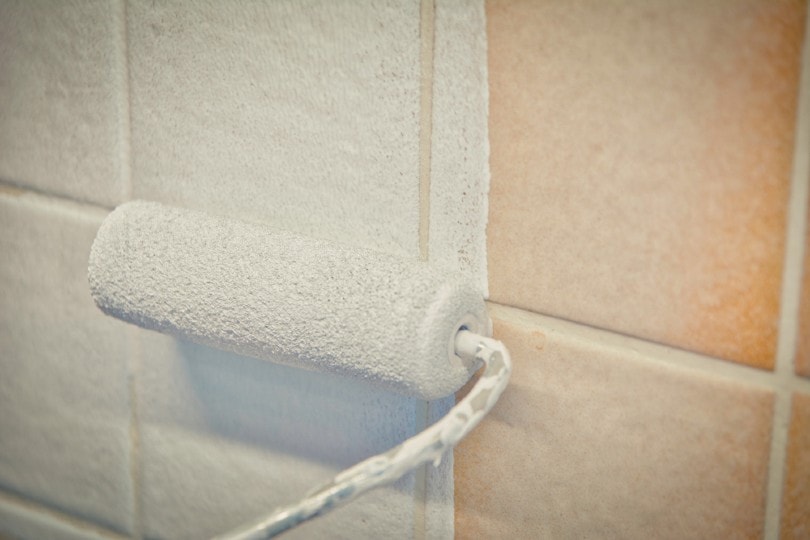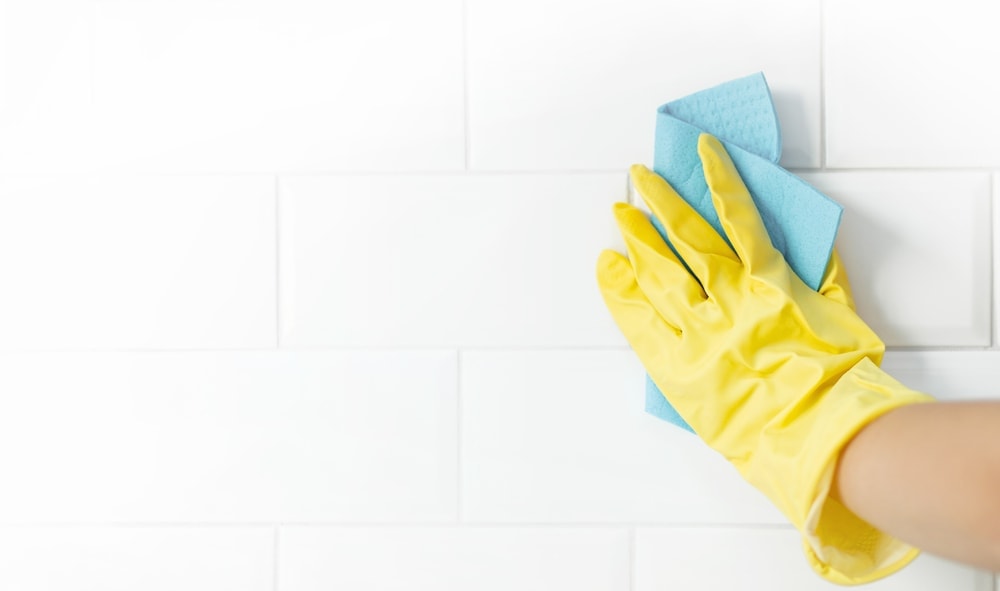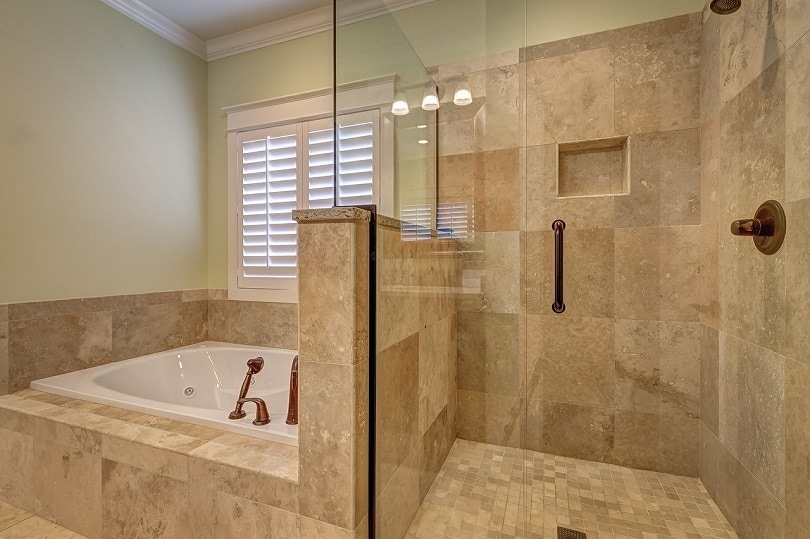How to Paint Bathroom Tiles in 11 Easy Steps
-
Ed Malaker
- Last updated:

Tiles are attractive and incredibly durable. Many people will find no real need to replace them in their entire lifetime, as they require little maintenance. However, the downside to such longevity is that you might get tired of looking at the same thing every day. This is particularly true if you weren’t the one who installed it and it’s not something that you like, anyway. Painting can be a good solution, but many people aren’t sure if there are special steps that they need to take or special paint to buy due to the hard surface and humid environment. If this sounds like your situation, keep reading as we provide you with a step-by-step guide to painting bathroom tile.
The 11 Steps for Painting Bathroom Tiles
- Paint
- Abrasive cleaner
- Primer
- Sponge
- Soft cloth
- Dish detergent
- Fan
- Dust mask
- Safety goggles
- Safety gloves
- Newspaper
- Plastic sheet
- Masking tape or painter’s tape
- Paintbrush
- Paint roller
- Putty knife

1. Clean and Prepare Your Tile
The first step in painting bathroom tile is to clean up the area to remove any dirt and light stains. We recommend using a soft cloth, dish soap, and water in this initial stage, as the main point is to wipe away the loose debris. Dish soap like Dawn will help break up oils and grease.
2. Abrasive Cleaner
Once you get the preliminary cleaning out of the way, it will be time to use a stronger abrasive cleaner to remove any stains, mildew, and soap scum that might remain. Typically, you wouldn’t want to use something abrasive on tile, but since you are about to paint it, any light scratches that occur as a result will help prepare the surface. You can use your favorite brand of abrasive cleaner, but something for lifting stains will work best.
3. Remove the Abrasive Cleaner
With the dirt and grime removed, you will also need to remove the cleaner. Many brands of abrasive cleaner leave residue behind, and it can take more than one good rinse to remove it all. Also, wipe down the area with a sponge or damp cloth. Any residue can prevent the paint from sticking, so it is essential to get it all off.

4. Allow to Dry
With all the dirt and cleaner removed, let the tile dry completely before proceeding. We recommend wiping it down with a dry cloth before giving it 4 to 5 hours to air dry. Open the windows if you can so there is plenty of ventilation, or use a fan to move the air around.
5. Sand the Surface
In this step, you will use 180-grit sandpaper to sand the surface gently. The goal here is not to dig into the tile or reshape it in any way, only to remove the gloss on top. Very gentle pressure is all that’s required. You must remove the gloss on all the tiles that you intend to paint so the paint will stick properly. It may be tempting to use power tools, like a hand sander, to get the job done faster, but it’s too easy to take off too much of the surface, so only use these tools if you have experience and feel that you can remove the gloss without doing additional damage.
Safety
We recommend wearing safety equipment while you complete this step because the sanding will put tiny particles in the air that can wind up in your eyes or lungs. A facemask can help protect the lungs, and a good pair of safety goggles will protect your eyes. It’s also a good idea to wear safety gloves while cleaning and sanding to protect your skin.
6. Clean and Dry
With the gloss removed from the tile, do another round of wiping down the tile with a damp cloth to remove any dust. With the dust eliminated, allow several hours for the surface to dry in good ventilation, and the surface will be ready for painting.

7. Cover Non-paintable Surfaces
With the surface ready to paint, it’s time to start covering any surfaces that you don’t want to paint with newspaper or a plastic sheet. If you need to, keep the covering in place using masking tape or painter’s tape, which won’t leave residue behind when you remove it. Don’t forget to cover the floor, as paint has a way of splattering.
8. Prime the Tile
You will need to paint a latex primer onto the tile. If you are not familiar with primer, it’s simply a thick paint that sticks well to many surfaces, including tile. It helps obscure any underlying color while providing a good base for your paint, which will help it stick better and have a longer lifespan. Paint the entire surface that you intend to paint with the primer, and allow it to dry overnight.
9. Lightly Sand the Primer
Once the primer dries, it’s a good idea to go over it lightly with the sandpaper again to remove any imperfections. Many people skip this step, but if there are any drips, bubbles, or rough patches, the paint on top will accent them instead of hide them. So, it’s important to inspect the surface carefully and sand away any blemishes before moving on to achieve the best possible finish.
10. Paint the Tile
Now it’s finally time to paint the tiles with latex paint. You can choose any color you like or even multiple colors. Most people will choose a gloss paint or at least a semi-gloss over the tile to keep the surface easy to clean and less likely to allow mold or mildew to grow. Many brands will offer bathroom paints with additives that give increased moisture resistance and other bonuses. Use a paintbrush in the corners and a roller on large flat surfaces for a nice even coat. Carefully wipe away any excess or drips with a damp cloth and a putty knife.
Safety
When you are painting, it’s important to wear safety goggles to help keep paint out of your eyes. It’s also important to ensure that there is plenty of ventilation, as many of these paints give off toxic fumes when wet. You might want to consider wearing a safety mask, especially if you have asthma or other lung-related issues. It’s also a good idea to wear protective clothing and a hat, as paint can get quite messy.
11. Let Dry
After you paint the surface, you will need to allow it time to dry. The instructions on the can of paint will give you the minimum wait time, but we recommend letting it sit as long as possible. Once it’s dry, you can remove the newspaper or plastic coverings and begin to use the area again. Your project is done!
Conclusion
While painting tiles requires a bit of elbow grease to complete and will likely take more than a day, it’s not hard, and you don’t need experience to succeed. Attention to detail, patience, and time spent finding high-quality paint and primer are all that’s required. Removing the gloss without pressing too hard and reshaping the tile is the most difficult part, especially in the corners and other hard-to-reach areas, but we think that you’ll be more than happy with the result if you follow these steps closely.
See Also:
- How to Paint Tile in 9 Easy Steps
- How to Paint Behind A Toilet In 7 Easy Steps
- How to Paint a Bathroom in 7 Easy Steps
Featured Image Credit: ristof Bellens, Shutterstock
Contents

